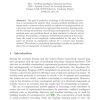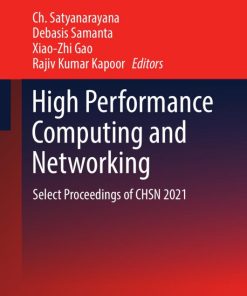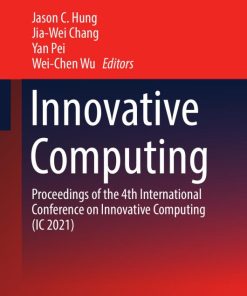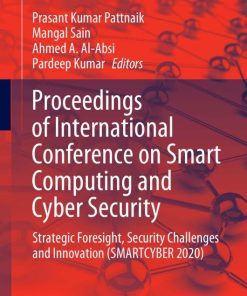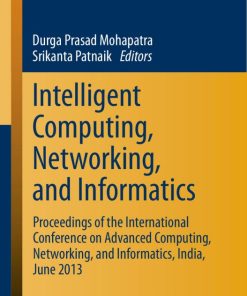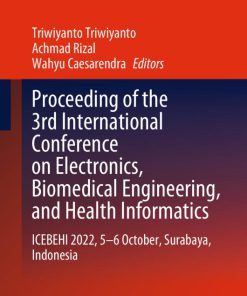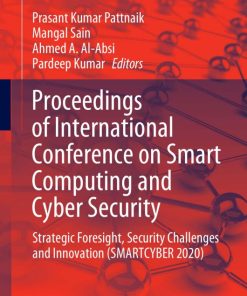Advanced Computing Networking and Informatics Volume 1 Advanced Computing and Informatics Proceedings of the Second International Conference on Advanced Computing, Networking and Informatics 1st Edition by Malay Kumar Kundu, Durga Prasad Mohapatra, Amit Konar, Aruna Chakraborty ISBN 3319073532 9783319073538
$50.00 Original price was: $50.00.$25.00Current price is: $25.00.
Authors:Malay Kumar Kundu; Durga Prasad Mohapatra; Amit Konar; Aruna Chakraborty , Series:IT & Computer [345] , Tags:Technology & Engineering; Engineering (General); Computers; Artificial Intelligence; General; Advanced Computing; Networking and Informatics- Volume 1 , Author sort:Kundu, Malay Kumar & Mohapatra, Durga Prasad & Konar, Amit & Chakraborty, Aruna , Ids:Google; 9783319073538 , Languages:Languages:eng , Published:Published:May 2014 , Publisher:Springer , Comments:Comments:Advanced Computing, Networking and Informatics are three distinct and mutually exclusive disciplines of knowledge with no apparent sharing/overlap among them. However, their convergence is observed in many real world applications, including cyber-security, internet banking, healthcare, sensor networks, cognitive radio, pervasive computing amidst many others. This two-volume proceedings explore the combined use of Advanced Computing and Informatics in the next generation wireless networks and security, signal and image processing, ontology and human-computer interfaces (HCI). The two volumes together include 148 scholarly papers, which have been accepted for presentation from over 640 submissions in the second International Conference on Advanced Computing, Networking and Informatics, 2014, held in Kolkata, India during June 24-26, 2014. The first volume includes innovative computing techniques and relevant research results in informatics with selective applications in pattern recognition, signal/image processing and HCI. The second volume on the other hand demonstrates the possible scope of the computing techniques and informatics in wireless communications, networking and security.
Advanced Computing, Networking and Informatics- Volume 1 Advanced Computing and Informatics Proceedings of the Second International Conference on Advanced Computing, Networking and Informatics 1st Edition by Malay Kumar Kundu, Durga Prasad Mohapatra, Amit Konar, Aruna Chakraborty – Ebook PDF Instant Download/Delivery. 3319073532, 9783319073538
Full download Advanced Computing, Networking and Informatics- Volume 1 Advanced Computing and Informatics Proceedings of the Second International Conference on Advanced Computing, Networking and Informatics 1st Edition after payment
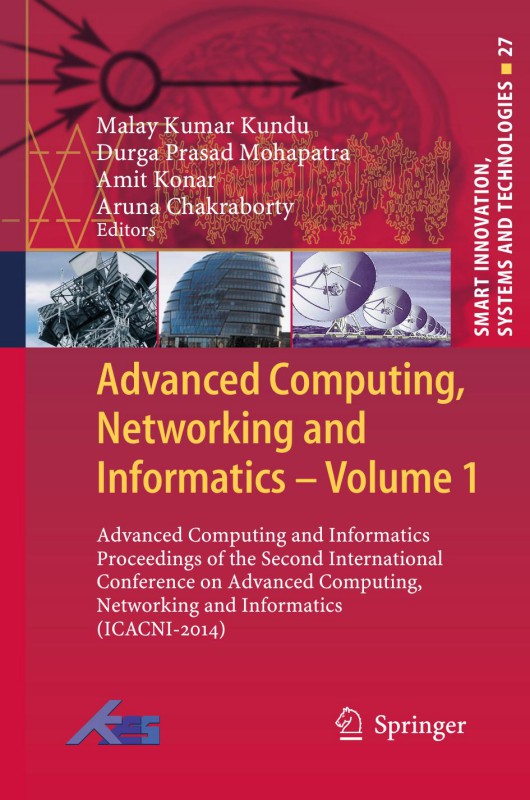
Product details:
ISBN 10: 3319073532
ISBN 13: 9783319073538
Author: Malay Kumar Kundu, Durga Prasad Mohapatra, Amit Konar, Aruna Chakraborty
Advanced Computing, Networking and Informatics are three distinct and mutually exclusive disciplines of knowledge with no apparent sharing/overlap among them. However, their convergence is observed in many real world applications, including cyber-security, internet banking, healthcare, sensor networks, cognitive radio, pervasive computing amidst many others. This two-volume proceedings explore the combined use of Advanced Computing and Informatics in the next generation wireless networks and security, signal and image processing, ontology and human-computer interfaces (HCI). The two volumes together include 148 scholarly papers, which have been accepted for presentation from over 640 submissions in the second International Conference on Advanced Computing, Networking and Informatics, 2014, held in Kolkata, India during June 24-26, 2014. The first volume includes innovative computing techniques and relevant research results in informatics with selective applications in pattern recognition, signal/image processing and HCI. The second volume on the other hand demonstrates the possible scope of the computing techniques and informatics in wireless communications, networking and security.
Advanced Computing, Networking and Informatics- Volume 1 Advanced Computing and Informatics Proceedings of the Second International Conference on Advanced Computing, Networking and Informatics 1st Table of contents:
1 Introduction
2 SINS Initial Alignments
2.1 Coarse Alignment
3 Theoretical Background
3.1 Bilinear RLS Algorithm (BRLS)
4 Dynamic Modeling
5 Dynamic Simulation of Fine Alignment
6 Results and Discussions
7 Conclusions
References
Time-Domain Solution of Transmission through Multi-modeled Obstacles for UWB Signals
1 Introduction
2 Propagation Environment
3 Proposed Transmission Model
3.1 TD Transmission Coefficient
3.2 Transmitted Field through the Propagation Environment
4 Results and Discussions
5 Conclusion
References
Indexing and Retrieval of Speech Documents
1 Introduction
2 Proposed Speech Indexing and Retrieval System
3 Performance Evaluation
4 Summary and Conclusions
References
An Improved Filtered-x Least Mean Square Algorithm for Acoustic Noise Suppression
1 Introduction
2 Problem Formulation
3 Simulation Setup
4 Simulation and Results
5 Conclusion
References
A Unique Low Complexity Parameter Independent Adaptive Design for Echo Reduction
1 Introduction
2 Existing Algorithms for AEC
3 Proposed Algorithm
4 Results and Discussion
5 Conclusion
References
On the Dissimilarity of Orthogonal Least Squares and Orthogonal Matching Pursuit Compressive Sensing
1 Introduction
2 Orthogonal Matching Pursuit
3 Orthogonal Least Squares
4 Simulation Results and Analysis
5 Conclusions
References
Machine Learning Based Shape Classification Using Tactile Sensor Array
1 Introduction
2 Related Work
3 Methodology
3.1 Tactile Image Enhancement
3.2 Feature Extraction
3.3 Machine Learning System
4 Experimental Set Up
5 Result and Discussion
6 Conclusion and Future Work
References
Multi-view Ensemble Learning for Poem Data Classification Using SentiWordNet
1 Introduction
2 Related Work
3 Preprocessing
4 Classification Using Multi-view Ensemble Learning
5 Experimental Setup and Results
6 Analysis
7 Conclusion
References
A Prototype of an Intelligent Search Engine Using Machine Learning Based Training for Learning to Ra
1 Introduction
2 Related Work
3 Proposed System m
4 Experimental Results
5 Case Study
6 Conclusions and Future Work
References
Vegetable Grading Using Tactile Sensing and Machine Learning
1 Introduction
2 Background
3 Proposed Methodology
4 Parameter Selection
5 Background of the Classifier Used
5.1 Support Vector Machine
5.2 K-Nearest Neighbor
6 Experimental Setup
7 Results and Discussions
8 Conclusion
References
Neural Networks with Online Sequential Learning Ability for a Reinforcement Learning Algorithm
1 Introduction
2 Approximation of Value Function Using mRAN
3 mRAN Learning Algorithm
4 Simulation Experiments
4.1 Two-Link Robot Manipulator
4.2 Controller Setup
4.3 Network Topologies and Learning Details
Results and Discussion
6 Conclusions
References
Scatter Matrix versus the Proposed Distance Matrix on Linear Discriminant Analysis for Image Pattern
1 Introduction
2 Idea Behind the Proposed Distance Matrix
3 Formulation of LDA Using Distance Based Symmetric Matrix
4 Experiments
5 Results and Conclusion
5.1 Experiment 1: Case Study on the Comparison of the
5.2 Experiment 2: Study on the Effect of Selection of Images on the Performance of Distance Matrix o
References
Gender Recognition Using Fusion of Spatial and Temporal Features
1 Introduction
2 Proposed Method
2.1 Face Detection
2.2 Preprocessing
3 Feature Extraction Techniques
3.1 Spatial Feature Extraction
3.2 Temporal Feature Extraction
3.3 Fusion of Features
4 Experimental Studies
5 Conclusions
References
The Use of Artificial Intelligence Tools in the Detection of Cancer Cervix
1 Introduction
2 Segmentation of CSV
2.1 Elimination of Inflammatory Cells
2.2 Image Segmentation in Experimental Phase
3 Shape Parameters
4 Methodologies of Classification per the Tools of Artificial Intelligence of the Vaginal Smears Cer
4.1 The Technique of Neural Networks (Multilayer Perceptron (MP))
4.2 The Technique of Fuzzy Logic
4.3 The Hybrid Approach: Neuro-Fuzzy
5 Simulation Results
6 Discussion
7 Conclusion
References
A Scalable Feature Selection Algorithm for Large Datasets – Quick Branch & Bound Iterative (QBB-I)
1 Introduction
2 Feature Selection Algorithms
2.1 Feature Selection
2.2 Quick Branch and Bound Iterative (QBB-I) Algorithm
3 Experimental Results of QBB-I
3.1 Dataset Used for Feature Selection
3.2 Experimental Setup
3.3 Results
4 Conclusion
References
Towards a Scalable Approach for Mining Frequent Patterns from the Linked Open Data Cloud
1 Introduction
2 Related Work
3 Mining Data from LOD Cloud Using COFI Tree Algorithm
4 Experimental Evaluation and Results
5 Conclusion and Future Work
References
Automatic Synthesis of Notes Based on Carnatic Music Raga Characteristics
1 Introduction
1.1 Basic Terms and Definitions
1.2 Fundamental Idea
2 Related Work
3 The Proposed Method
3.1 First Order Markov Model
3.2 Hidden Markov Model
4 Assumptions and Constraints
5 Results and Analysis
6 Conclusion and Future work
References
Smart Card Application for Attendance Management System
1 Introduction
2 Related Work
3 Entities in The Smart Card System
4 Set up
5 Implementation
6 Conclusion
References
Performance Evaluation of GMM and SVM for Recognition of Hierarchical Clustering Character
1 Introduction
1.1 Related Work
1.2 Outline of the Work
2 Proposed Hierarchical Character Recognition
2.1 Dataset
2.2 Pre-processing
3 Character Intensity Vector
4 Hierarchical Character Clustering
5 Gaussian Mixture Model
6 Support Vector Machine
7 Experimental Results
7.1 Handwritten Dataset
7.2 Evaluation Metrics
7.3 Classifier
8 Conclusion
References
Data Clustering and Zonationof Earthquake Building Damage Hazard Area Using FKCN and Kriging Algorit
1 Introduction
2 FKCN Algorithm: Development and Its Application
3 Methodology
4 Analysis and Result
4.1 Resulting Cluster Data Validation
4.2 Clusterization of Building Damage Hazard Data
4.3 Zonation of Earthquake Building Damage Hazard Area
5 Conclusion
References
Parametric Representation of Paragraphs and Their Classification
1 Introduction
2 Classification of Paragraph
3 Parameterizations of a Paragraph
3.1 Identification of Parameters
3.2 Extraction of Parameter Values
3.3 Data Preprocessing
3.4 Identification of Outliers and Removal
3.5 Training and Testing
4 Experimental Result
5 Conclusion and Future Scope
References
LDA Based Emotion Recognition from Lyrics
1 Introduction
2 Literature Survey
3 System Design
3.1 System Architecture
3.2 Steps in Emotion Recognition
4 Implementation and Evaluation
4.1 LDA Parameters
4.2 Emotion Recognition
4.3 Evaluation
5 Conclusion and Future Work
References
Efficient Approach for Near Duplicate Document Detection Using Textual and Conceptual Based Techniqu
1 Introduction
2 Related Work
3 Proposed Approach
4 Experimental Results
4.1 Determination of Optimum Values for Parameters Involved in Algorithm
4.2 Comparison of Proposed Approach with Traditional Simhash Implementation
5 Conclusion and Future Work
References
Decision Tree Techniques Applied on NSL-KDD Data and Its Comparison with Various Feature Selection T
1 Introduction
2 Methods and Materials
2.1 Decision Tree
2.2 Feature Selection
2.3 NSL-KDD Data
3 Experimental Work
4 Conclusion
References
Matra and Tempo Detection for INDIC Tala-s
1 Introduction
3 PastWork
4 Proposed Methodology
4.1 Extraction of Peaks from Amplitude Envelope
4.2 Detection of
5 Experimental Results
6 Conclusion
References
Modified Majority Voting Algorithm towards Creating Reference Image for Binarization
1 Introduction
2 The Proposed Methodology
2.1 Proposed Method
3 Experimental Verification
4 Conclusions
References
Multiple People Tracking Using Moment Based Approach
1 Introduction
2 Methodology
2.1 Robust Multiple People Tracking
2.2 HSV Range Identif fication
2.3 Moment Calculation
2.4 Calculation of Away and Toward Parameter
2.5 Calibration Techniques
3 Experiment Results
3.1 Single Person Tracking
3.2 Multiple Person(s) Tracking
4 Discussion
5 Conclusion
References
Wavelets-Based Clustering Techniques for Efficient Color Image Segmentation
1 Introduction
2 Haar Wavelet Transformation
3 Clustering Technique on Images
4 Proposed Image Segmentation Technique Using Color Feature
5 Proposed Segmentation Technique Using Color and Texture
6 Experimental Results
7 Future Scope and Conclusion
References
An Approach of Optimizing Singular Value of YCbCr Color Space with q-Gaussian Function in Image Proc
1 Introduction
2 Architecture of Radial Basis Function Neural Network
3 Analysis
4 Simulation
5 Conclusion
References
Motion Tracking of Humans under Occlusion Using Blobs
1 Introduction
2 Related Works
3 Object Tracking
3.1 Background Modelling
3.2 Segmentation
Object Representation and Feature Selection
5 Proposed Tracking Algorithm
5.1 Blob Tracking Approach
5.2 Particle Filter Trac cking Approach
6 Results and Discussion
7 Conclusion
References
Efficient Lifting Scheme Based Super Resolution Image Reconstruction Using Low Resolution Images
1 Introduction
2 Super Resolution Image Reconstruction
3 Lifting Schemes
3.1 Lifting Scheme of the Daubechies4 Wavelet Transforms
3.2 SPHIT Technique
4 Proposed Super Resolution Reconstruction
Measurement of Performance
6 Results
7 Conclusion
References
Improved Chan-Vese Image Segmentation Model Using Delta-Bar-Delta Algorithm
1 Introduction
2 The C-V Algorithm
3 The GDS Method and the Delta-Bar-Delta Algorithm
4 The MDBR Algorithm for Level Set Based Image Segmentation
5 Implementation and Results
6 Conclusions
References
Online Template Matching Using Fuzzy Moment Descriptor
1 Introduction
2 Required Tools
2.1 Arduino Based Mobile Robot with Camera
2.2 Template Matching Using Fuzzy Moment Descriptor
2.3 Fuzzy Membership Distributions
2.4 Fuzzy Production Rules
2.5 Fuzzy Moment Descriptors
3 Tracking Algorithm
4 Experiment on Mobile Robot
5 Conclusion and Future Work
References
Classification of High Resolution Satellite Images Using Equivariant Robust Independent Component An
1 Introduction
2 A Proposed Framework for Satellite Image Classification
2.1 Equivariant Robust Independent Component Analysis (ERICA)
3 Results and Discussion
3.1 Performance Index and Accuracy Assessment
4 Conclusion and Future Scope
References
3D Face Recognitionacross Pose Extremities
1 Introduction
2 An Overview of the Proposed System
2.1 Select the 3D-Database Directory
2.1.1 Cropping
2.2 Preprocess 2.5D Range Image and Register by Hausdorff’s Distance Metric
2.3 Registrationby Hausdorff’s Distance Metric
2.4 Feature Extraction and Classification by Normal Points
3 Our Contribution and a Comparative Analysis with other 3D Registration Systems
4 Experimental Results
4.1 Recognition of Registered Images
5 Conclusion and Future Scope
References
Indexing Video Database for a CBVCD System
1 Introduction
2 Past Work
3 Proposed Methodology
3.1 Selection of Shot Representative
3.2 Indexing the Database of Representative Frames
4 Experimental Result
5 Conclusion
References
Data Dependencies and Normalization of Intuitionistic Fuzzy Databases
1 Introduction
1.1 An Example
2 Intuitionistic Fuzzy Sets and Human Logic
3 Normalization
4 Related Work
5 Proposed Intuitionistic Fuzzy Normalization
6 Intuitionistic Fuzzy Normal Forms
6.1 Intuitionistic Fuzzy Equality
6.2 Intuitionistic Fuzzy Functional Dependency
6.3 Normalization Process
7 Conclusion
References
Fuzzy Logic Based Implementation for Forest Fire Detection Using Wireless Sensor Network
1 Introduction
2 Related Works
3 Problem Statement
4 Proposed Solution for Forest Fire Detection
5 Network Topology for Energy Efficient WSN
6 Simulation and Results
7 Conclusion
References
Fuzzy Connectedness Based Segmentation of Fetal Heart from Clinical Ultrasound Images
1 Introduction
2 Methodology
2.1 Probabilistic Patch Based Weighted Maximum Likelihood
2.2 Fuzzy Connectedness Based Image Segmentation
3 Quantitative Validation of Segmentation
4 Results and Discussion
5 Conclusion
References
An Improved Firefly Fuzzy C-Means (FAFCM) Algorithm for Clustering Real World Data Sets
1 Introduction
2 Fuzzy C-Means Algorithm
3 Firefly Algorithms (FA)
4 Particle Swarm Optimization
5 Proposed Clustering Approach
5.1 Firefly Based Fuzzy C-Means Clustering (FAFCM)
5.2 Improved Firefly Based Fuzzy C-Means Clustering
6 Experimental Analysis
6.1 Parameter Set Up
6.2 Experimental Results
7 Conclusion and Future Work
References
On Kernel Based Rough Intuitionistic Fuzzy C-means Algorithm and a Comparative Analysis
1 Introduction
2 Definitions and Notations
2.1 Performance Indexes
2.1.1 Davis-Bouldin (DB) Index
2.1.2 Dunn (D) Index
3 Kernel Methods
3.1 Types of Distance Functions
4 The c-Means Clustering Algorithms
4.1 Intuitionistic Fuzzy C-Means
5 Kernel Based Rough Intuitionistic Fuzzy C-Means
5.1 The KRIFCM Algorithm
6 Experimental Analysis
6.1 Image Dataset
6.2 Numeric Dataset
7 Conclusion
References
FuSCa: A New Weighted Membership Driven Fuzzy Supervised Classifier
1 Introduction
2 Preliminary
3 Proposed Algorithm and Implementation
4 Experimental Analysis
4.1 Performance Evaluation
4.2 Friedman Test
5 Conclusion
References
Choice of Implication Functions to Reduce Uncertainty in Interval Type-2 Fuzzy Inferences
1 Introduction
2 Selection of the Most Efficient Implication Function that Minimizes the Span of Uncertainty
2.1 Type-1 and Type-2 Inference Technique
2.2 Metric of Span of Uncertainty (SOU) in Terms of UMF and LMF
2.3 Measure of SOU for Various Fuzzy Implication Function
2.4 Comparative Study
3 Conclusion
References
Detection of Downy Mildew Disease Present in the Grape Leaves Based on Fuzzy Set Theory
1 Introduction
2 Preliminaries
2.1 Diseases in Grape L Leaves
2.2 Featured used in th he Proposed Techniques
2.3 Fuzzy Value
3 Proposed Technique
3.1 Feature Selection Based on Fuzzy Value
3.2 Detection of Diseased Image
4 Experimental Results
5 Conclusion
References
Facial Expression Synthesis for a Desired Degree of Emotion Using Fuzzy Abduction
1 Introduction
2 Determination of Desired Facial Features for a Given Degree of Emotions by Fuzzy Abduction
2.1 Principles of Fuzzy Abduction
2.2 Determining Features for a Desired Degree of Emotion for Emotion Synthesis Applications
3 Experiments
3.1 Membership Function Construction
3.2 Implication Relatio on Construction
3.4 Results
4 Conclusions
References
A Novel Semantic Similarity Based Technique for Computer Assisted Automatic Evaluation of Textual An
1 Introduction
2 Previous Work
3 Proposed Methodology
3.1 Preprocessing Tasks
3.2 Steps for the Evaluation of the Learner Response
4 Experiments and Results
4.1 Set 1
4.2 Set 2
5 Conclusion
References
Representative Based Document Clustering
1 Introduction
2 Boundary Entropy and Frequency as Segmentation Measures
3 The Sequence Segmentation Algorithm
4 Representative Based Document Clustering
5 Experiments
6 Conclusions and Future Work
References
A New Parallel Thinning Algorithm with Stroke Correction for Odia Characters
1 Introduction
2 Existing Thinning Algorithms
3 Stroke Preserving Thinning Algorithm
4 Stroke Corrections
5 Experimental Results
6 Conclusions
References
Evaluation of Collaborative Filtering Based on Tagging with Diffusion Similarity Using Gradual Decay
1 Introduction
2 Related Work
2.1 Collaborative Filter ring
2.2 Collaborative Filter ring Based on Tagging
2.3 Neighborhood Formation Using Diffusion Similarity
2.4 Prediction and Recommendation
3 Proposed Work CF Framework Based on Tagging with Diffusion Similarity Using Gradual Decay Approach
3.1 Collaborative Filtering Based on Tagging Using Gradual Decay Approach
4 Experiments
4.1 Datasets
4.2 Results
4.3 Analysis of Results
5 Conclusion
References
Rule Based Schwa Deletion Algorithm for Text to Speech Synthesis in Hindi
1 Introduction
1.1 Hindi Writing System and Schwa
2 Terminology Used
3 Algorithm for Schwa Deletion
3.1 For 1 Block Length Word
3.2 For 2 Block Length Word
3.3 For 3 Block Length Word
3.4 For 4 Block Length Word
4 Results
5 Conclusion and Future Work
References
Unsupervised Word Sense Disambiguation for Automatic Essay Scoring
1 Introduction
2 Existing Systems
2.1 Project Essay Grader (PEG)
2.2 E-Rater
2.3 Intelligent Essay Assessor (IEA)
2.4 Corpus-Based Word Sense Disambiguation (WSD)
2.5 Graph-Based Word Sense Disambiguation Using Measures of
3 Automated Essay Scoring with WSD
3.1 WSD Process
3.2 Scoring Model Using Multiple Regression Analysis
4 Results and Performance Evaluation
4.1 Kappa Score
5 Conclusion
References
Disjoint Tree Based Clustering and Merging for Brain Tumor Extraction
1 Introduction
2 Related Work
3 Proposed Approach
3.1 Disjoint Tree Generation
3.2 Tree Merging
4 Experimental Results
4.1 Dataset Used
4.2 Results and Discussion
5 Conclusion
References
Segmentation of Acute Brain Stroke from MRI of Brain Image Using Power Law Transformation with Accur
1 Introduction
2 Proposed Methodology
3 Results and Discussion
4 Quantification and Accuracy Estimation
5 Conclusion
References
A Hough Transform Based Feature Extraction Algorithm for Finger Knuckle Biometric Recognition System
1 Introduction
2 The Proposed System Design
2.1 Preprocessing and ROI Extraction
2.2 Elliptical Hough Transform Based Feature Extraction Method
2.3 Feature Information Representation
2.4 Classification
2.5 Matching Score Level Fusion
3 Experimental Analysis and Results Discussion
4 Conclusion
References
An Efficient Multiple Classifier Based on Fast RBFN for Biometric Identification
1 Introduction
1.1 Classifier Performance Evaluation
2 Overview of the System and Approach
2.1 Preprocessing
2.2 Theory of Operation
3 Result and Performance Analysis
3.1 Training Set
3.2 Test Set
4 Conclusion
References
Automatic Tortuosity Detection and Measurement of Retinal Blood Vessel Network
1 Introduction
2 Background
2.1 Determination of Furcation and Branches
2.2 Relation Between Arc and Chord:
2.3 Tortuosity Features:
3 Proposed Method
3.1 Vessel Skeleton Extraction
3.2 Breaking Into Branches
3.3 Rotating Vessel Branches and Partitioning into Segments by Finding Maximum Distance from Chord
3.4 Tortuosity Measurement
3.5 Tortuosity Detection
4 Experimental Results
5 Conclusion
References
A New Indexing Method for Biometric Databases Using Match Scores and Decision Level Fusion
1 Introduction
2 Proposed Indexing Methodology
2.1 Selection of Sample Image Set
3 Retrieval of Best Matches (Identification)
3.1 Fusion of Decisions Output
4 Experimental Results
4.1 Retrieval Time
4.2 Comparison with Other Indexing Techniques
5 Conclusions
References
Split-Encoding: The Next Frontier Tool for Big Data
1 Motivation
2 Introduction
3 Related Work
4 Design and Implementation
4.1 Split-Encoding Scheme # 1
5 Experimental Results
5.1 Experimental Setup
5.2 Performance Measurement
6 Conclusion
References
Identification of Lost or Deserted Written Texts Using Zipf’s Law with NLTK
1 Introduction
2 Background Theory
3 Motivation
4 Getting Started
5 Result Analysis
6 Conclusion and Future Work
References
An Efficient Approach for Discovering Closed Frequent Patterns in High Dimensional Data Sets
1 Introduction
2 Related Work
3 Preliminaries
4 Proposed Approach for Discovering Frequent Pattern
5 Results and Discussion
6 Conclusion and Future Scope
References
Time-Fading Based High Utility Pattern Mining from Uncertain Data Streams
1 Introduction
2 Preliminaries
3 Related Work
3.1 Proposed Work
3.2 Complexity Analysis of Landmark and Sliding Window Tree Structures
4 Experimental Results
5 Conclusions
References
Classification for Multi-Relational Data Mining Using Bayesian Belief Network
1 Introduction
2 Related Work
2.1 Inductive Logic Programming (ILP)
2.2 Probabilistic Approaches
2.3 Graph-Based Approach
3 Background Theory
3.1 Bayesian Belief Network
3.2 Semantic Relationship Graph (SRG)
3.3 Tuple-ID Propagation
4 Proposed Approach
5 Conclusion and Future Work
References
Noise Elimination from Web Page Based on Regular Expressions for Web Content Mining
1 Introduction
2 Preliminaries
3 Proposed Method
3.1 Filtering
3.2 Regular Expression
3.3 Noise Detection in SST [13]3.4 Proposed Algorithm
4 Experimental Results
5 Conclusion
References
Modified Literature Based Approach to Identify Learning Styles in Adaptive E-Learning
1 Introduction
2 Related Works
3 Methodology
3.1 Felder-Silverman Learning Style Model (FSLSM)
3.2 E-learning Framework
4 Experimentation Details
5 Experimentation Design
6 Results and Discussion
7 Conclusion
References
A Concept Map Approach to Supporting Diagnostic and Remedial Learning Activities
1 Introduction
2 System Overview
3 Implementation in M-Learning Environment
4 Experiments
5 Conclusion
References
Data Prediction Based on User Preference
1 Introduction
2 Model for Collaborative Filtering
3 The Aspect Model
4 Implementation Details
4.1 Dataset
5 Results and Analysis
6 Conclusion
References
Automatic Resolution of Semantic Heterogeneity in GIS: An Ontology Based Approach
1 Introduction
2 Proposed Semantic Matching Framework
3 Implementation and Results
4 Conclusion
References
Web-Page Indexing Based on the Prioritized Ontology Terms
1 Introduction
2 Related Works
3 Proposed Approach
3.1 Extraction of Dominating and Sub-Dominating Ontology Terms
3.2 Proposed Algorithm of Web-Page Indexing
3.3 Web-page Retrieval Mechanism
4 Experimental Analyses
4.1 Time Complexity to Produce Resultant Web-Page List
4.2 Experimental Result
5 Conclusions
References
A Hybrid Approach Using Ontology Similarity and Fuzzy Logic for Semantic Question Answering
1 Introduction
2 Background
2.1 Question and Answering System
2.2 Ontology
2.3 Data Clustering
3 Methodology Description
4 Conclusion and Future Work
References
Ontology Based Object-Attribute-Value Information Extraction from Web Pages in Search Engine Result
1 Introduction
1.1 Semantic Web
1.2 Ontology
1.3 Knowledge Representation
1.4 WordNet
1.5 RDF and RDFS
2 Related Work
3 Ontology Based Information Extraction from Web Pages
3.1 Proposed Architecture for O-A-V Evaluation
3.2 Algorithms
4 A Light Weight Ontology Based Search Engine
4.1 Proposed Architecture for O-A-V Representation
5 Conclusions and Future Work
References
Effects of Robotic Blinking Behavior for Making Eye Contact with Humans
1 Introduction
2 Related Work
3 System Overview
4 Experiments
4.1 Experiment 1: Effect of Eye Blinks
4.2 Experiment 2: Effect of Blink Duration
5 Conclusion
References
Improvement and Estimation of Intensity of Facial Expression Recognition for Human-Computer Interact
1 Introduction
2 Optical Flow Based Feature Extraction
3 Rule Based Generation by Training a Decision Tree
4 Improvement in Intensity of Expressions Based on Component Based Analysis
5 Estimation of Expression Intensity Based on Manhattan Distance Metric
6 System’s Performance Compared to Human Perception
7 Conclusion
References
Cognitive Activity Recognition Based on Electrooculogram Analysis
1 Introduction
2 Principles and Methodology
2.1 Electrooculogram Signal Acquisition and Pre-processing
2.2 Feature Extraction
2.3 Classification
3 Experiments and Results
4 Conclusions and Future Scopes
References
Detection of Fast and Slow Hand Movements from Motor Imagery EEG Signals
1 Introduction
2 Experiments and Methods
2.1 Visual Cue
2.2 Experimental Setup
2.3 Pre-processing
2.4 Feature Extraction
2.5 Classification
3 Results and Discussions
4 Conclusion and Future Direction
References
A Solution of Degree Constrained Spanning Tree Using Hybrid GA with Directed Mutation
1 Introduction
2 Degree Constrained Spanning Tree
3 Solution Methodology
3.1 Representation of Chromosomes in GA in ST Problems
3.2 Generation of Initial Population
3.3 Graphical Edge-Set t Crossover
3.4 Graphical Edge-Set t Directed Mutation
4 Experimental Result and Comparison
5 Conclusion
References
Side Lobe Reduction and Beamwidth Control of Amplitude Taper Beam Steered Linear Array Using Tscheby
1 Introduction
2 Beam Steered Linear Array and Tschebyscheff Polynomial
3 PSO on Linear Array Design
4 Proposed Method
5 Experimental Setup and Results
6 Conclusion
References
Pervasive Diary in Music Rhythm Education: A Context- Aware Learning Tool Using Genetic Algorithm
1 Introduction
2 Related Works
3 Fundamentals of Music Rhythm
4 Experimental Details
4.1 Overview of Pervasive Diary in Music Rhythm Education
4.3 Generation of Rhythm Matrix
4.4 Fitness Function
4.5 Parent Music Rhythm Selection Strategy Using Linear Rank Method
5 Result Set Analysis and User Interface Design
6 Conclusion
References
An Elitist Binary PSO Algorithm for Selecting Features in High Dimensional Data
1 Introduction
2 Preliminaries
2.1 Binary Particle Swarm Optimization (BPSO)
2.2 Non-dominated Sorting Algorithm
2.3 k-NN Classifier
3 Proposed Approach
3.1 Preprocessing Data
3.2 Fitness Function
3.3 Elitist BPSO Method
4 Results and Discussions
4.1 Gene Expression Data Sets
4.2 Results
5 Conclusion
References
An Immune System Inspired Algorithm for Protein Function Prediction
1 Introduction
2 Background of the Problem
2.2 Formulation of the Problem
2.3 Solution Representation and Cost Function Evaluation
3 An Overview of Clonal Selection Algorithm (CSA)
4 Experiments and Results
5 Conclusion
References
Fast Approximate Eyelid Detection for Periocular Localization
1 Introduction
2 Related Works
3 Proposed Fast Eyelid Detection
4 Experimental Results
5 Conclusion
References
Prediction of an Optimum Parametric Combination for Minimum Thrust Force in Bone Drilling: A Simulat
1 Introduction
2 Experimental Pr rocedure
2.1 Experimental Desig gn Based on Response Surface Methodology
2.2 Experimental Deta ils
3 Development of Mathematical Model
4 Optimization of the Thrust Force with SA
5 Conclusions
People also search for Advanced Computing, Networking and Informatics- Volume 1 Advanced Computing and Informatics Proceedings of the Second International Conference on Advanced Computing, Networking and Informatics 1st:
advanced computing, networking and informatics- volume 1
advanced computer networking course
advanced cloud computing cmu
advanced computing normal il
advanced informatics



